In this video are presented some extraordinary experiments with prismatic colors which I want to explain further down:
This video exposes very obviously the whole emptiness of the Newton’s theory of colors.
Please watch it carefully (especially its later part) before reading this post.
The key for an explanation of the prismatic colors and the extraordinary experiments presented in this video is the “principle of the arrow”. I call you to remember this phrase very well because it will certainly be the milestone of the future science.
What is the principle of the arrow? Although I have elaborated it many times in my older answers and posts, still I will repeat the main points here for those who haven’t read them (I will also cite some articles of mine at the end of this post).
When a body moves through space filled with air, then higher pressure is created in front of it, while lower pressure behind it. The higher pressure is Plus, the lower pressure is Minus. I use to call it the ‘principle of the arrow’ (− >—> +).
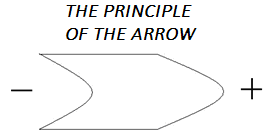
The greater the velocity of the body is, the stronger is the plus in front of it as well as the minus behind it.
And look now: this very principle can be found wherever the light produces colors. The archetype of this pattern is the flame of a candle or a cigarette lighter. A violet/cyan minus appears at the back and a yellow/red plus at the front of this fiery arrow:
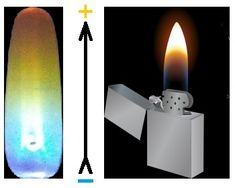
The left picture is a real photograph of an opalite stone illuminated from below with a white LED lamp. ( Opalites are very cheap stones and easy to find. I urge everyone who is really interested in light and colors to find these stones. )
Let’s find the same principle in the phenomenon of refraction colors, that is, the colors which appear on a triangular prism.
The light undergoes two refractions on the prism: one on entering the prism and another on emerging from it. For the birth of the refraction colors there is no need of a double, but only of a single refraction. In the following video it is visible how the colors appear only with one refraction (from 0:48 to 0:57 on the timeline, please watch it on full screen):
Let me jump for a moment to something else, to the question of the so-called Bernoulli’s principle (footnote 1). Please look at the picture below:
(footnote 1) There is actually no such thing as Bernoulli’s principle. It is ridiculous to call a principle after a man’s name. If someone has discovered a principle, then its name should be descriptive, just as “the principle of the arrow” is a descriptive name. The phenomena which the “Bernoulli’s principle” refers to are only particular cases of the principle of the arrow.
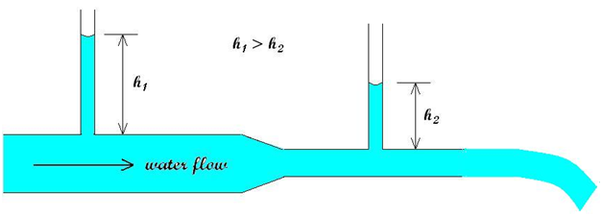
The water flows through a wider pipe and then through a narrower pipe. The velocity of the water increases in the narrower pipe. As a result, the water column over it is lower than over the wider pipe. Why is that so?
The water columns over the pipes could be imagined as many tails of the water-body. Since the velocity of the water is greater in the narrower pipe, a stronger MINUS occurs in its tail than in the tail of the wider pipe, thus the air-pressure from above lowers the water column over the narrower pipe more. At the same time a stronger PLUS arises at the front part of the narrower pipe. Everyone knows that the water-jet which comes out of a pipe reaches farther if we narrow the pipe. That happens because higher pressure occurs in the front part.
So, HIGHER PRESSURE within the plus-side of the water-body, while LOWER PRESSURE within its minus-side.
But could the water-body with the higher pressure in its plus-side and the lower-pressure in its minus-side exist without a material environment, that is, without the surrounding air? No, it could not. The surrounding air is an inevitable actor in the whole story.
I want here to stress that in the case of the moving solid body, the higher and the lower pressure arise in the surrounding air, while in the case of the moving liquid body, they arise within it.
Let us get back to the light. When the light propagates through the void space, then there is nothing around it to strike its body in, so it propagates freely. But when there is more or less transparent matter on its way of propagation, then it experiences resistance, so that higher light-pressure arises in the front of its body, while lower light-pressure in the back. The higher light-pressure manifests itself as yellow-red, the lower pressure as violet-cyan.
When a beam of light propagates through space, its frontal surface is at right angle to the direction of propagation. We can call it a frontal propagation of light. But when the beam is refracted, then it propagates sideways, meaning that its frontal surface is no longer perpendicular to the direction of propagation. We can call it a sideways propagation of light.
These two ways of propagation can be imagined as follows: imagine two threads stretched across a room, one horizontally, the other diagonally. On each of the threads is hanging a pierced sheet of paper. We are moving the two sheets along the threads so that they are always in a vertical position. In the figure (a) below is represented the frontal propagation, while in the figure (b) the sideways propagation. The sheet in the figure (b) does not have to be necessarily vertical. It only must not be at right angle to the direction of the thread.

Please look at the diagram below:
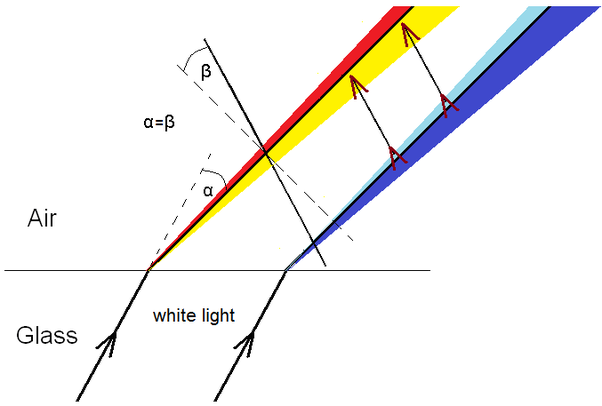
A beam of light is refracted. After the refraction, besides the normal component, the beam gets an additional component in the direction marked with the black arrows. Higher light-pressure arises at the front of this component (i.e. plus-colors), while lower light-pressure (i.e. minus-colors) at its back. But these different light-pressures can occur due to the surrounding air, similarly to the cases of the solid and the liquid body. In other words, if we place a prism or a diffraction grating in a very high vacuum, then I claim that the refracted or diffracted white light will remain white after passing through them.
Now, please look at this screenshot from the video:
A beam of light has passed through the prism, but the colored boundaries are covered with black papers.
Let’s say that the source of light and the prism are placed in a black box and you see only the beam presented in the screenshot. Then someone asks you:
He: What do you see?
You: A beam of white light.
He: Is it a normal light?
You: What kind of question is that? Of course it is a normal white light!
He: No, it is not a normal light. Watch now!
And then he places an object in the middle of the beam (screenshot below).
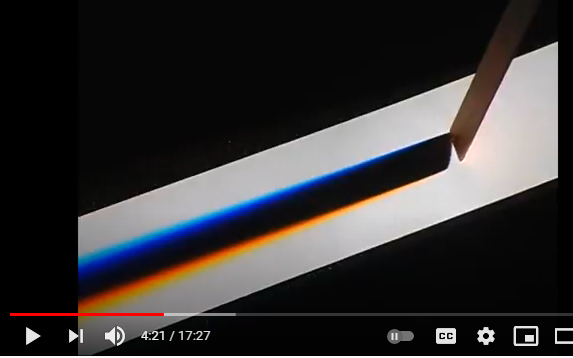
He: Does a normal light throw a shadow like this?!
You: No, it doesn’t … then, what kind of light is this?
He: It’s not a normal, but a slanted light.
Let us now move to the experiments when only one colored ray of the so-called Goethe’s spectrum passes through a narrow slit (screenshot below):
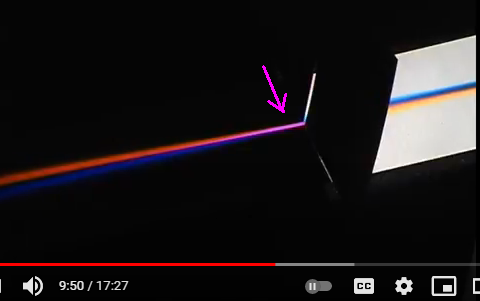
There are actually three cases:
- the cyan ray passes through the slit; after that we see a green ray and a blue ray bound together;
- the magenta ray (the author of the video calls it purple; Goethe called it also purple) passes through the slit; after that we see a red ray and a blue ray separated from each other;
- the yellow ray passes through the slit; after that we see a green ray and a blue ray bound together.
In the screenshot above only the second case is presented for the sake of shortness.
The magenta arrow is added by me to stress a very important detail, that is, the ray has still its own color in the close vicinity of the slit. The same applies for the cyan ray and the yellow ray when they exit the slit.
Before I explain what is going on here, let me tell you something else.
Please look at the figure below:
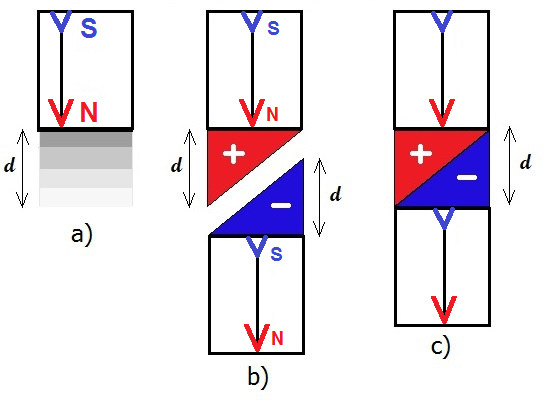
The magnetic field of the magnet is weaker at a greater distance from the magnet’s pole (figure a). At a greater distance than d, we could say that the strength of the magnetic field is practically zero. The weakening of the strength is symbolically represented by the different shades of gray.
The weakening is also symbolically represented by the red and the blue triangle in the figure (b). If the two identical magnets are brought at the distance ‘d’ (or less than ‘d’) without allowing them to come together, then in the interspace between them there is a uniform magnetic field because the two fields complement each other. This means that the strength of the magnetic field is the same in every point of the interspace (figure c).
The magnetic field is uniform in terms of strength, but it is not homogeneous in terms of polarity. The Plus and the Minus retain their character just as before the bringing of the magnets close to each other.
Something similar to the things just discussed we have with light. Look please at the screenshot below:
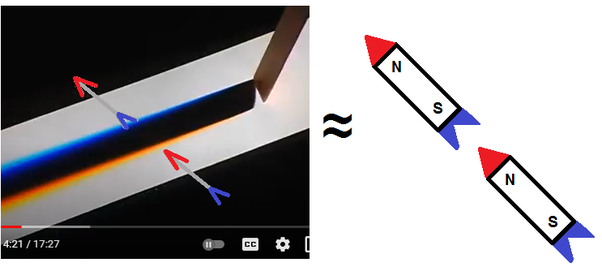
The light above the plate’s shadow and the light below it can be imagined as two separate beams of light. Since these beams are far from each other, there is no interaction between them. It corresponds in a way to the two magnets which are far from each other.
Look now at this screenshot:
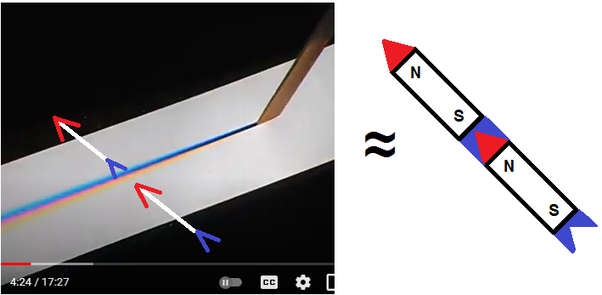
The shadow is now narrow so that an interaction between the beams can occur. The Plus from below meets the Minus from above, that is, the red color meets the blue-violet. Their overlapping bears magenta. This is not the same case as when we mix chemical colors. If we mix acrylic red and acrylic blue-violet, we do get magenta, but we cannot bring the process back, that is, we cannot separate it into two colors. With the light it is possible.
On the right of the last image, the corresponding situation with two magnets is presented. When the magnets are close to each other, then their fields interact, but, as I said before, the Plus and the Minus retain their character. In relation to this, please read (link at the end of this passage) about another hoax of the contemporary science, the so-called Fleming’s left hand rule. This rule states that if a current-carrying conductor is placed in a uniform magnetic field, then it will experience a force which is perpendicular to the magnetic lines of force. This is true only in the case when the conductor is placed exactly in the middle between the magnets, where the strength of the Plus and the Minus are equal. In every other case it is not true that the force acts perpendicularly to the magnetic lines of force. (see these articles Is the Fleming’s left hand rule valid? and A physics task to be solved (Part 2))
The plane which is exactly between the magnets corresponds in a sense to the magenta color of the Goethe’s spectrum.
Now, let’s get back to this screenshot:
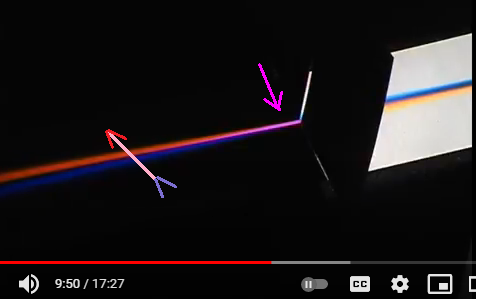
What is actually going on here? The magenta ray enters an environment of low light-pressure, i.e. the pressure around the ray suddenly drops. Therefore, it is a suitable environment for it to dissolve in the original Plus and Minus components.
Please note a very interesting detail in this process. Before the slit in the last screenshot, the magenta ray comes about through mixing of the red ray from below with the blue-violet from above. After the slit the ray splits into a red ray above, while the blue-violet one is below, that is, the rays have exchanged the places.
What does this tell? It tells that this ray behaves as the original refracted light (marked with the added three-colored arrow) although it is born from rays of reverse order.
But we can say also otherwise: the red and the blue-violet ray retain their own directions just as if they were not mixed before the slit.
Look now at this screenshot:
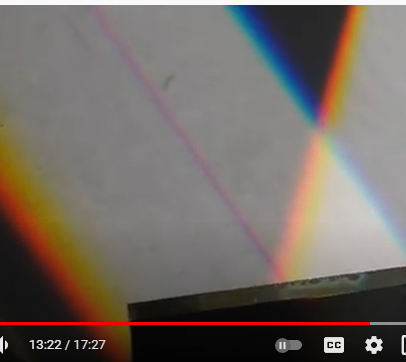
In this case the magenta ray doesn’t split into two. Why? Because it enters an environment of high light-pressure. The forces around it are so strong that it cannot fall apart.
I leave the other variations of the experiments to the reader to try to explain them on his/her own.
Here are some important articles of mine related to this post:
Why is the sky blue? How does light make colors appear?
P.S. The author of the video succeeded to split also the green ray in its constituent parts, yellow and cyan, but it is not presented in the video.
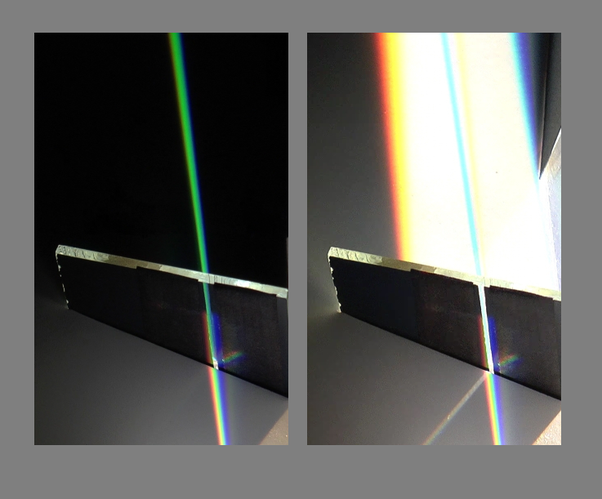
It is presented on his website. Here is the link where you can find this photo:
Inverted spectra of monochromatic rays
P.P.S. I was once asked what the comparison with water was for? It was to show that the water cannot exist and cannot show its properties if there is not an air surrounding it. In the void space, it will fall apart and there will be no water anymore. The air pressure actually keeps the water-body together.
Similarly, the magenta and the green fall apart or don’t fall apart depending on whether there is some light pressure or no light pressure surrounding them.

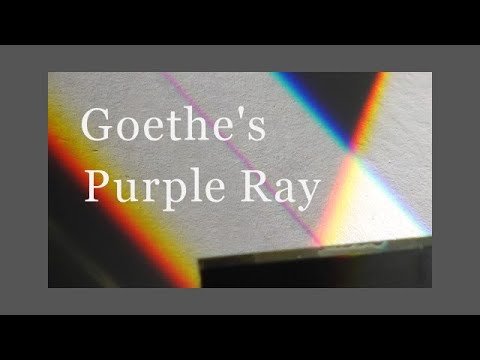
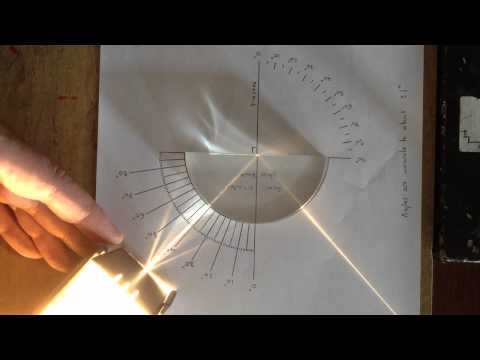
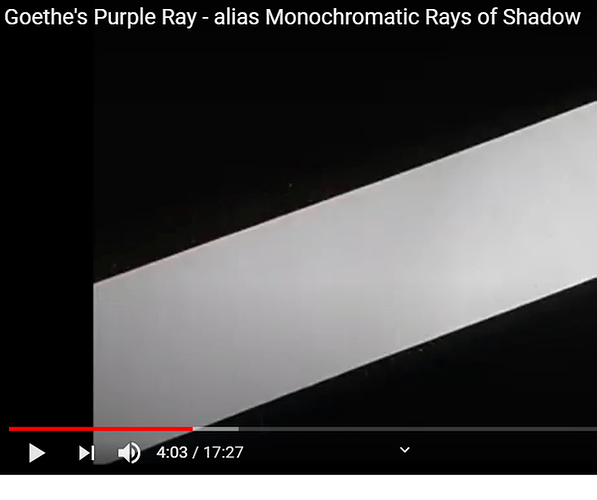

![The impressively huge galaxy cluster MACS J1149.5+223, whose light took over 5 billion years to... [+] reach us, was the target of one of the Hubble Frontier Fields programs. This massive object gravitationally lenses the objects behind it, stretching and magnifying them, and enabling us to see more distant recesses of the depths of space than in a relatively empty region. The lensed galaxies are among the most distant of all, and can be used to test the nature of redshift in our Universe.](https://thumbor.forbes.com/thumbor/960x0/https%3A%2F%2Fblogs-images.forbes.com%2Fstartswithabang%2Ffiles%2F2018%2F05%2Fheic1505b-1200x1200.jpg)
![An ultra-distant view of the Universe shows galaxies moving away from us at extreme speeds. At those... [+] distances, galaxies appear more numerous, smaller, less evolved, and to recede at great redshifts compared to the ones nearby.](https://thumbor.forbes.com/thumbor/960x0/https%3A%2F%2Fblogs-images.forbes.com%2Fstartswithabang%2Ffiles%2F2017%2F09%2F9k-1200x1140.jpg)
![The visible light spectrum of the Sun, which helps us understand not only its temperature and... [+] ionization, but the abundances of the elements present. The long, thick lines are hydrogen and helium, but every other line is from a heavy element that must have been created in a previous-generation star, rather than the hot Big Bang. These elements all have specific signatures corresponding to explicit wavelengths.](https://thumbor.forbes.com/thumbor/960x0/https%3A%2F%2Fblogs-images.forbes.com%2Fstartswithabang%2Ffiles%2F2016%2F10%2Fsuny-1200x800.jpg)
![First noted by Vesto Slipher back in 1917, some of the objects we observe show the spectral... [+] signatures of absorption or emission of particular atoms, ions, or molecules, but with a systematic shift towards either the red or blue end of the light spectrum.](https://thumbor.forbes.com/thumbor/960x0/https%3A%2F%2Fblogs-images.forbes.com%2Fstartswithabang%2Ffiles%2F2017%2F09%2Fslipher.jpg)
![An object moving close to the speed of light that emits light will have the light that it emits... [+] appear shifted dependent on the location of an observer. Someone on the left will see the source moving away from it, and hence the light will be redshifted; someone to the right of the source will see it blueshifted, or shifted to higher frequencies, as the source moves towards it.](https://thumbor.forbes.com/thumbor/960x0/https%3A%2F%2Fblogs-images.forbes.com%2Fstartswithabang%2Ffiles%2F2016%2F03%2Fblur.jpg)
![An illustration of how redshifts work in the expanding Universe. As a galaxy gets more and more... [+] distant, it must travel a greater distance and for a greater time through the expanding Universe. If the Universe were contracting, the light would appear blueshifted instead.](https://blogs-images.forbes.com/startswithabang/files/2018/02/redshifts.gif?)
![The original 1929 observations of the Hubble expansion of the Universe, followed by subsequently... [+] more detailed, but also uncertain, observations. Hubble's graph clearly shows the redshift-distance relation with superior data to his predecessors and competitors; the modern equivalents go much farther.](https://thumbor.forbes.com/thumbor/960x0/https%3A%2F%2Fblogs-images.forbes.com%2Fstartswithabang%2Ffiles%2F2017%2F01%2Fkirsch.jpg)
![According to the tired light hypothesis, the number of photons-per-second we receive from each... [+] object drops proportional to the square of its distance, while the number of objects we see increases as the square of the distance. Objects should be redder, but should emit a constant number of photons-per-second as a function of distance. In an expanding universe, however, we receive fewer photons-per-second as time goes on because they have to travel greater distances as the Universe expands, and the energy is also reduced by the redshift. Even factoring in galaxy evolution results in a changing surface brightness that's fainter at great distances, consistent with what we see.](https://thumbor.forbes.com/thumbor/960x0/https%3A%2F%2Fblogs-images.forbes.com%2Fstartswithabang%2Ffiles%2F2019%2F03%2FTolman_surface_brightness_test.jpg)
![The 3D reconstruction of 120,000 galaxies and their clustering properties, inferred from their... [+] redshift and large-scale structure formation. The data from these surveys allows us to perform deep galaxy counts, and we find that the data is consistent with an expansion scenario, not an initial explosion.](https://thumbor.forbes.com/thumbor/960x0/https%3A%2F%2Fblogs-images.forbes.com%2Fstartswithabang%2Ffiles%2F2017%2F08%2FSDSS-Galaxy-Map-Wedge-1200x559.jpg)
![The differences between a motion-only based explanation for redshift/distances (dotted line) and... [+] General Relativity's (solid) predictions for distances in the expanding Universe. Definitively, only General Relativity's predictions match what we observe.](https://thumbor.forbes.com/thumbor/960x0/https%3A%2F%2Fblogs-images.forbes.com%2Fstartswithabang%2Ffiles%2F2017%2F09%2Fred-dots.jpg)
![This image shows SDSS J0100+2802 (center), the brightest quasar in the early Universe. It's light... [+] comes to us from when the Universe was only 0.9 billion years old, versus the 13.8 billion year age we have today. Based on its properties, we can infer a distance to this quasar of ~28 billion light-years. We have thousands of quasars and galaxies with similar measurements, establishing beyond a reasonable doubt that redshift is due to the expansion of space, not to a Doppler shift.](https://thumbor.forbes.com/thumbor/960x0/https%3A%2F%2Fblogs-images.forbes.com%2Fstartswithabang%2Ffiles%2F2018%2F07%2Fultra_luminous_quasar.jpg)